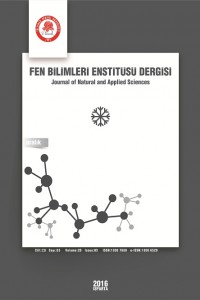Öz
In this study, to determine the functional subgroups of the components of Euphorbia anacampseros Boiss., which is a perennial endemic species, FTIR (Fourier Transform Infrared) spectroscopy method was adopted. The results showed that hydrocarbons particularly terpenoids, alkanes and olefin structures exist in the composition of E. anacampseros Boiss. IR spectra of E. anacampseros Boiss. samples collected at different stations screened different peak points. There is a correlation between the vibrational frequency values and the altitudes of the areas where E. anacampseros Boiss. samples were collected. This study is the first attempt in analyzing of this species by using FTIR method.
Anahtar Kelimeler
Kaynakça
- [1] Güner, A., Aslan, S., Ekim, T., Vural, M., Babaç, M. T. 2012. Türkiye bitkileri listesi (damarlı bitkiler). Birinci basım. Nezahat Gökyiğit Botanik Bahçesi ve Flora Araştırmaları Derneği Yayını. İstanbul, Türkiye, 1290 pp.
- [2] Webster, G. L. 1994. Classification of the Euphorbiaceae. Annals of the Missouri Botanical Garden, 81(1), 3-32.
- [3] Zimmermann, N. F. A., Ritz, C. M., Hellwig, F. H. 2010. Further support for the phylogenetic relationships within Euphorbia L. (Euphorbiaceae) from nrITS and trnL–trnF IGS sequence data. Plant Systematics and Evolution, 286(1-2), 39-58.
- [4] Pahlevani, A. H., Maroofi, H., Joharchi, M. R. 2011. Notes on six endemic or rare species of Euphorbia subg. Esula (Euphorbiaceae) in Iran. Willdenowia, 41(2), 267-276.
- [5] Ekim, T., Koyuncu, M., Vural, M., Duman, H., Aytaç, Z., Adıgüzel, N. 2000. Türkiye Bitkileri Kırmızı Kitabı. Birinci Basım, Ankara, Türkiye, 246 pp.
- [6] Barla, A., Öztürk, M., Kültür, Ş., Öksüz, S. 2007. Screening of antioxidant activity of three Euphorbia species from Turkey. Fitoterapia, 78(6), 423-425.
- [7] Özbilgin, S., Çitoğlu, G. S. 2012. Uses of some euphorbia species in traditional medicine in Turkey and their biological activities. Turkish Journal of Pharmaceutical Sciences, 9(2), 241-255.
- [8] Shi, Q. W., Su, X. H., Kiyota, H. 2008. Chemical and pharmacological research of the plants in genus Euphorbia. Chemical reviews,108, 4295-4327.
- [9] Kırbağ, S., Erecevi,t P., Zengin, F., Güvenç, A. N. 2013. Antimicrobial activities of some Euphorbia species. African Journal of Traditional, Complementary and Alternative Medicines, 10(5), 305-309.
- [10] Al-Qura'n, S. 2005. Ethnobotanical survey of folk toxic plants in southern part of Jordan. Toxicon, 46(2), 119-129.
- [11] Baloch, I. B., Baloch, M. K., us-Saqib, Q. N. 2005. Tumor-Promoting Diterpene Esters from Latex of Euphorbia cauducifolia L. Helvetica chimica acta, 88(12), 3145-3150.
- [12] Wu, Q. C., Tang, Y. P., Ding, A. W., You, F. Q., Zhang, L., Duan, J. A. 2009. 13C-NMR data of three important diterpenes isolated from Euphorbia species. Molecules, 14(11), 4454-4475.
- [13] Pütün, A. E., Gerçel, H. F., Koçkar, Ö. M., Ege, Ö., Snape, C., Pütün, E. 1996. Oil production from an arid-land plant: fixed-bed pyrolysis and hydropyrolysis of E. rigida. Fuel, 75(11), 1307–1312.
- [14] Ateş, F., Pütün, A. E., Pütün, E. 2005. Fixed bed pyrolysis of Euphorbia rigida with different catalysts. Energy Conversion and Management, 46(3), 421-432.
- [15] Davis, P. H. 1978. Flora of Turkey and East Aegean Islands vol. 6. Edinburgh University Press. Edinburgh, 824 pp.
- [16] Özcan, A., Pütün, A. E., Keith, D. B., Pütün, E. 2000. Structural Analysis of Bio-Oils from Fixed-Bed Pyrolysis of Euphorbia rigida and Sunflower Pressed Bagasse. Energy Sources, 22, 809–824.
- [17] Tuncel, F., Gerçel, H. F. 2004. Production and Characterization of Pyrolysis Oils from Euphorbia macroclada. Energy Sources, 26, 761–770.
- [18] Pütün, E., Ateş, F., Pütün, A. E. 2008. Catalytic pyrolysis of biomass in inert and steam atmospheres. Fuel, 87, 815-824.
- [19] Dutta, S., Mallick, M., Bertram, N., Greenwood, P. F., Mathews, R. P. 2009. Terpenoid composition and class of Tertiary resins from India. International Journal of Coal Geology, 80, 44 –50.
- [20] Gerçel, Ö., Özcan, A., Özcan, A. S., Gerçel, H. F. 2007. Preparation of activated carbon from a renewable bio-plant of Euphorbia rigida by H2SO4 activation and its adsorption behavior in aqueous solutions. Applied Surface Science, 253, 4843–4852.
- [21] Domenech-Carbo, M. T., Kuckova, S., de la Cruz-Canizares, J., Osete-Cortina, L. 2006. Study of the influencing effect of pigments on the photoageing of terpenoid resins used as pictorial media. Journal of Chromatography A, 1121, 248–258.
- [22] Chitra, M., Muga, V., Sasikumar, D., Awdah, M. A. 2011. Screening of Phytochemical and In vitro activity of Euphorbia hirta L. J. Chem. Pharm. Res., 3(6), 110-114.
- [23] Ogunlesi, M., Okiei, W., Osibote, A. E. 2009. Analysis of the essential oil from the dried leaves of Euphorbia hirta Linn (Euphorbiaceae), a potential medication for asthma. African Journal of Biotechnology, 8(24), 7042-7050.
- [24] Kokalj, M., Kolar, J., Trafela, T., Kreft, S. 2011. Differences among Epilobium and Hypericum species revealed by four IR spectroscopy modes: transmission, KBr tablet, diffuse reflectance and ATR. Phytochemical Analysis, 22(6), 541-546.
Ayrıntılar
| Bölüm | Makaleler |
|---|---|
| Yazarlar | |
| Yayımlanma Tarihi | 22 Ağustos 2016 |
| Yayımlandığı Sayı | Yıl 2016 Cilt: 20 Sayı: 3 |
Kaynak Göster
Cited By
e-ISSN :1308-6529
Linking ISSN (ISSN-L): 1300-7688
Dergide yayımlanan tüm makalelere ücretiz olarak erişilebilinir ve Creative Commons CC BY-NC Atıf-GayriTicari lisansı ile açık erişime sunulur. Tüm yazarlar ve diğer dergi kullanıcıları bu durumu kabul etmiş sayılırlar. CC BY-NC lisansı hakkında detaylı bilgiye erişmek için tıklayınız.


